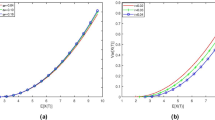Abstract
In this paper, we consider the optimal investment and optimal reinsurance problems for an insurer under the criterion of mean-variance with bankruptcy prohibition, i.e., the wealth process of the insurer is not allowed to be below zero at any time. The risk process is a diffusion model and the insurer can invest in a risk-free asset and multiple risky assets. In view of the standard martingale approach in tackling continuous-time portfolio choice models, we consider two subproblems. After solving the two subproblems respectively, we can obtain the solution to the mean-variance optimal problem. We also consider the optimal problem when bankruptcy is allowed. In this situation, we obtain the efficient strategy and efficient frontier using the stochastic linear-quadratic control theory. Then we compare the results in the two cases and give a numerical example to illustrate our results.


Similar content being viewed by others
Explore related subjects
Discover the latest articles and news from researchers in related subjects, suggested using machine learning.References
Bai, L., & Zhang, H. (2008). Dynamic mean-variance problem with constrained risk control for the insurers. Mathematical Methods of Operations Research, 68, 181–205.
Bäuerle, N. (2005). Benchmark and mean-variance problems for insurers. Mathematical Methods of Operations Research, 62, 159–165.
Bielecki, T. R., Jin, H., Pliska, S. R., & Zhou, X. Y. (2005). Continuous-time mean-variance portfolio selection with bankruptcy prohibition. Mathematical Finance, 15, 213–244.
Browne, S. (1995). Optimal investment policies for a firm with a random risk process: exponential utility and minimizing the probability of ruin. Mathematics of Operations Research, 20, 937–957.
Delong, L., & Gerrard, R. (2007). Mean-variance portfolio selection for a non-life insurance company. Mathematical Methods of Operations Research, 66, 339–367.
El Karoui, N., Peng, S., & Quenez, M. C. (1997). Backward stochastic differential equations in finance. Mathematical Finance, 7, 1–71.
Fleming, W. H., & Soner, H. M. (1993). Controlled Markov processes and viscosity solutions. Berlin: Springer.
Gaier, J., Grandits, P., & Schachermayer, W. (2003). Asymptotic ruin probabilities and optimal investment. The Annals of Applied Probability, 13, 1054–1076.
Grandell, J. (1991). Aspects of risk theory. New York: Springer.
Hipp, C., & Plum, M. (2000). Optimal investment for insurers. Insurance. Mathematics & Economics, 27, 215–228.
Luenberger, D. G. (1968). Optimization by vector space methods. New York: Wiley.
Markowitz, H. (1952). Portfolio selection. The Journal of Finance, 7, 77–91.
Merton, R. C. (1972). An analytical derivation of the efficient portfolio frontier. Journal of Financial and Quantitative Analysis, 7, 1851–1872.
Pardoux, E., & Peng, S. (1990). Adapted solution of a backward stochastic differential equation. Systems & Control Letters, 14, 55–61.
Pliska, S. R. (1982). A discrete time stochastic decision model. In W. H. Fleming & L. G. Gorostiza (Eds.), Lecture notes in control and information sciences: Vol. 42. Advances in filtering and optimal stochastic control (pp. 290–302). New York: Springer.
Pliska, S. R. (1986). A stochastic calculus model of continuous trading: optimal portfolios. Mathematical Methods of Operations Research, 11, 371–384.
Schmidli, H. (2002). On minimizing the ruin probability by investment and reinsurance. The Annals of Applied Probability, 12, 890–907.
Wang, Z., Xia, J., & Zhang, L. (2007). Optimal investment for an insurer: the martingale approach. Insurance. Mathematics & Economics, 40, 322–334.
Zhou, X. Y., & Li, D. (2000). Continuous time mean-variance portfolio selection: a stochastic LQ framework. Applied Mathematics & Optimization, 42, 19–33.
Acknowledgements
The authors acknowledged the support of Social Science Foundation of Ministry of Education of China (10YJC790196) and Chinese National Natural Science Fund (Nos. 70772006, 71102110, 71172171, 71140006).
Author information
Authors and Affiliations
Corresponding author
Rights and permissions
About this article
Cite this article
Bi, J., Meng, Q. & Zhang, Y. Dynamic mean-variance and optimal reinsurance problems under the no-bankruptcy constraint for an insurer. Ann Oper Res 212, 43–59 (2014). https://doi.org/10.1007/s10479-013-1338-z
Published:
Issue Date:
DOI: https://doi.org/10.1007/s10479-013-1338-z



